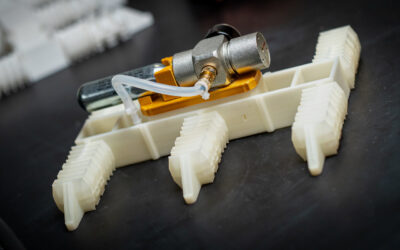AI, machine learning, and robotics have significantly improved drug discovery and manufacturing. But in the costly and risky business of pharmaceuticals, these tools still have room to make an impact on an overlooked section of the development pipeline: drug formulation.
After drug discovery and before clinical testing and manufacturing, a promising medicinal molecule is formulated, meaning it is packaged in a way that it can be delivered safely and effectively to the body — as a tablet, a nasal spray, or an injection for example.
Though no less important, this complex part of development process for any new medication is often neglected by this advancing technology.
According to researchers at the University of Toronto, AI-assisted, automated approaches to drug formulation is still evolving and presents untapped potential, one that in addition to producing more effective new drugs, could revitalize old ones too.
Sifting through a mass of possibilities
If a drug is the passenger, drug formulation is designing the plane, says Christine Allen, professor and researcher in the Faculty of Pharmacy at the University of Toronto. While most drugs stick with conventional designs that have been used before, there is little guarantee this is the best one.
“The challenge with formulations, or designing formulations, is it’s very complicated,” she explained. For an oral medicine, she says there are over 10 billion combinations of materials or ingredients possible, “and nobody’s going to go and evaluate all 10 billion of those possibilities.”
AI and machine learning algorithms would appear to be the perfect tool for sifting through this mass of possibilities. However, an early attempt to use AI in Allen’s lab aimed at predicting how a drug might be released from a polymer particle revealed flaws in this assumption.
“We curated the data set from the literature, took some from our own lab, and used that data to train machine learning models,” Allen said. It wasn’t long before problems emerged.
“There’s data that’s missing or information that’s missing in the literature, and those are pieces of information that you would need to train your machine learning models,” she said.
Teaming up with robotics
To help fill in the gaps, Allen’s group started using lab equipment that is automated to rapidly carry out standard experiments and generate missing data quickly and accurately.
The team had now independently brought two powerful new tools into the lab — AI and automation — but it wasn’t until they let go of conventional large thinking and merged the two in a new way that their potential for drug formulation was realized.
The first revelation was moving away from massive training datasets. Instead, Allen and colleagues developed an AI driven robotic platform. “We’re not actually reliant on these large data sets,” she explained. “What we do is we plug in the drug we’re interested in. We plug in all of the different excipients or materials that we can use for formulation, and then we can optimize from a series of objectives.”
These objects are everything from tablet size to how quickly the tablet disintegrates, to how much drug is released, and even costs of the materials. Of the billions of possible formulations the AI determines a reasonable starting set and begins to hone in on the optimal one.
The automated platform rapidly creates and tests the initial formulations after which the data is then fed back to retrain the algorithm and produce the next batch of formulations. “It’s a closed loop until we identify formulation options that match that target product profile,” said Allen.
Allen believes this approach has the potential to not only dramatically speed up research, but that it will increase efficacy as well. According to her, better formulations would help more drugs pass clinical trials.
“This is what gives rise, I think, to many of the clinical failures that we see, the use of sub optimal formulations,” she said. With this approach, drugs entering the clinical stage can be formulated to give them the best chance at success.
Breathing new life into pharma
This method could also resurrect promising molecules that failed clinical trials and improve formulations for existing drugs. Allen’s start-up, Intrepid Labs, is doing just that.
“What the company’s doing is it’s looking at drugs that have come off patent, or are coming off patent, and we’re reformulating them,” said Allen.
In tests done in her lab, they’ve designed formulations in days to weeks that outperform formulations that are currently on the market for characteristics like bioavailability, which is the amount of drug that makes it to the bloodstream.
The existence of AI and automation in the adjacent areas of drug discovery and manufacturing should ease their integration into pharmaceutical company workflows.
Allen and her team have been mindful of scalability as they built this approach. “I see this as being a very smooth transition,” she said.
“We need to stop accepting this very high failure rate that’s associated with drug development, and we just need to think about embracing and adopting these technological advancements across the entire pipeline.”
Reference: Christine Allen, et al., The Dawn of a New Pharmaceutical Epoch: Can AI and Robotics Reshape Drug Formulation? Advanced Healthcare Materials (2024). DOI: 10.1002/adhm.202401312

![_RLP1046 copy 2-min[65] Scientists working with robotics in the lab to help speed up drug formulation.](https://www.advancedsciencenews.com/wp-content/uploads/2024/09/RLP1046-copy-2-min65.jpg)












